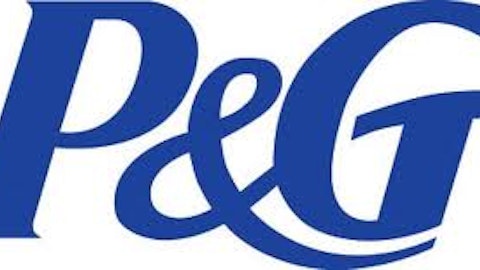Questioning certain companies in today’s stock market is almost unheard of. When you think about names like The Coca-Cola Company (NYSE:KO), McDonald’s Corporation (NYSE:MCD), or The Procter & Gamble Company (NYSE:PG), many investors assume that all of these companies are stocks that they can buy at any price and hold forever. While it’s true that investors may be able to buy the shares at a decent price and tuck them away for many years, I have yet to witness a stock that is completely immune to valuation concerns. In Procter & Gamble’s case, the company has improved its business, but investors buying at today’s prices need to understand that this stock is no sure bet.
That’s More like It
For several years when I read over The Procter & Gamble Company (NYSE:PG)’s quarterly reports, I couldn’t help but notice that the company said it witnessed organic growth (i.e. price increases) even when volumes declined. With a very large company like this, I prefer to see volume growth, which is a more reliable indicator of increased demand.

In the current quarter, The Procter & Gamble Company (NYSE:PG)’s net sales increased 2%, which is about in-line with the 2.5% sales growth at Colgate-Palmolive Company (NYSE:CL), and the 1% increase at both The Clorox Company (NYSE:CLX) and Kimberly Clark Corp (NYSE:KMB). However, Kimberly-Clark and Colgate-Palmolive both saw strong volume growth, whereas Clorox’s volume growth was weak, and Procter & Gamble’s volume growth was mixed.
There was a very clear pattern at The Procter & Gamble Company (NYSE:PG) that held across the board. When the company left their product lineup alone, competition and promotional pricing caused volumes to drop. When Procter & Gamble innovated and introduced new products, volume increased. The good news for investors is, in 3 of the 5 operating segments volume was up, and it seems like Procter & Gamble is finally getting the message that name brands alone aren’t enough to generate sales growth.
3 Issues Standing in the Way
If the The Procter & Gamble Company (NYSE:PG) story ended with the company increasing its organic volume growth, it would be hard to argue against a dividend aristocrat with a better than 3% yield. However, the company still seems to have several challenges that long-term investors should be aware of.
First, even though The Procter & Gamble Company (NYSE:PG) makes a big deal of it share repurchases, the bottom line effect on the company’s diluted share count leaves something to be desired. In the last year, Procter & Gamble retired over $4 billion worth of shares, but because of new shares being issued, the overall diluted share count only dropped by 0.24%.
By comparison, Colgate-Palmolive Company (NYSE:CL) repurchased enough shares to reduce its diluted share count by 2.36%, and Kimberly Clark Corp (NYSE:KMB) retired 1.66% of its shares. Of this group, only The Clorox Company (NYSE:CLX) saw its diluted share count increase. The point is, if The Procter & Gamble Company (NYSE:PG) has to spend $4 billion to retire 0.24% of its shares, investors should wonder if this money could be spent more wisely elsewhere.
Second, The Procter & Gamble Company (NYSE:PG) isn’t generating enough free cash flow to cover their dividends and share repurchases. For instance, the company reported free cash flow of just over $8 billion, and spent $4.8 billion on dividends, and nearly $5 billion on share repurchases. Given that all of these share repurchases have barely moved the diluted share count down, investors should be concerned.
Third, and maybe most important, The Procter & Gamble Company (NYSE:PG)’s stock value is no great bargain at current prices. To compare companies that pay dividends, I use the PEG + Y ratio. This ratio adds the company’s current yield to its expected earnings growth rate, and then divides by the company’s projected P/E ratio. This allows investors to get an apples to apples comparison of companies with different yields and different expected growth rates.
Using this formula, The Procter & Gamble Company (NYSE:PG)’s roughly 3% yield and 7.6% expected growth rate does not compare favorably to the company’s forward P/E ratio of nearly 20. Procter & Gamble scores a PEG + Y ratio of 0.54, which is second worst to The Clorox Company (NYSE:CLX). Clorox’s slightly higher yield, but lower expected growth rate and similar P/E ratio make the stock tough to recommend.
Both Colgate-Palmolive Company (NYSE:CL) and Kimberly Clark Corp (NYSE:KMB) look like better options for investors. Colgate-Palmolive has a lower yield at 2.3%, but is expected to grow faster at about 9.1%. The company’s P/E ratio is only slightly higher than Procter & Gamble, which gives Colgate-Palmolive a PEG + Y of 0.55.
The best value of the bunch might be Kimberly Clark Corp (NYSE:KMB), which carries a higher yield than The Procter & Gamble Company (NYSE:PG) at 3.3%, and is expected to grow slightly faster at 7.8%; it also sells for a P/E ratio of around 17, which is cheaper than Procter & Gamble. The combination of these favorable traits gives Kimberly-Clark a PEG + Y ratio of 0.64.
While investors seem excited that The Procter & Gamble Company (NYSE:PG) is reporting positive volume growth in several of its divisions, you can see the company is not without challenges. Investors are paying almost 20 times projected earnings for a company that is expected to grow earnings at less than 8%. My concern for these investors is that they are paying up for the Procter & Gamble name, whereas customers have been willing to trade away from Procter & Gamble’s products to cheaper options. Maybe investors should take a lesson from the average consumer, and look for a cheaper option than Procter & Gamble.
Chad Henage owns shares of Colgate-Palmolive. The Motley Fool recommends Kimberly-Clark and Procter & Gamble.
The article Can This Blue Chip Keep up the Turnaround? originally appeared on Fool.com.
Copyright © 1995 – 2013 The Motley Fool, LLC. All rights reserved. The Motley Fool has a disclosure policy.




